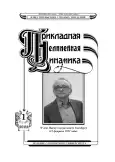Selection of spatial modes in an ensemble of non-locally coupled chaotic maps
- Authors: Shabunin A.V.1
-
Affiliations:
- Saratov State University
- Issue: Vol 30, No 1 (2022)
- Pages: 109-124
- Section: Articles
- URL: https://journals.rcsi.science/0869-6632/article/view/251994
- DOI: https://doi.org/10.18500/0869-6632-2022-30-1-109-124
- ID: 251994
Cite item
Full Text
Abstract
About the authors
Aleksej Vladimirovich Shabunin
Saratov State Universityul. Astrakhanskaya, 83, Saratov, 410012, Russia
References
- Анищенко В. С., Постнов Д. Э., Сафонова М. А. Размерность и физические свойства хаотических аттракторов цепочки связанных генераторов // Письма в ЖТФ. 1985. Т. 11, № 24. С. 1505-1509.
- Анищенко В. С., Арансон И. С., Постнов Д. Э., Рабинович М. И. Пространственная синхронизация и развитие бифуркаций в цепочке связанных осцилляторов // Доклады Академии наук СССР. 1986. Т. 286, № 5. С. 1120-1124.
- Fujisaka H., Yamada T. Stability theory of synchronized motion in coupled-oscillator systems // Progress of Theoretical Physics. 1983. Vol. 69, no. 1. P. 32-47. doi: 10.1143/PTP.69.32.
- Yamada T., Fujisaka H. Stability theory of synchronized motion in coupled-oscillator systems. II: The mapping approach // Progress of Theoretical Physics. 1983. Vol. 70, no. 5, P. 1240-1248. doi: 10.1143/PTP.70.1240.
- Anishchenko V. S., Vadivasova T. E., Postnov D. E., Safonova M. A. Synchronization of chaos // International Journal of Bifurcation and Chaos. 1992. Vol. 2, no. 3. P. 633-644. doi: 10.1142/S0218127492000756.
- Heagy J. F., Carroll T. L., Pecora L. M. Synchronous chaos in coupled oscillator systems // Phys. Rev. E. 1994. Vol. 50, no. 3. P. 1874-1884. doi: 10.1103/PhysRevE.50.1874.
- Ren L., Ermentrout B. Phase locking in chains of multiple-coupled oscillators // Physica D. 2000. Vol. 143, no. 1-4. P. 56-73. doi: 10.1016/S0167-2789(00)00096-8.
- Шабунин А. В., Акопов А. А., Астахов В. В., Вадивасова Т. Е. Бегущие волны в дискретной ангармонической автоколебательной среде // Известия вузов. ПНД. 2005. Т. 13, № 4. C. 37-55. doi: 10.18500/0869-6632-2005-13-4-37-55.
- Kuramoto Y. Chemical Oscillations, Waves, and Turbulence. Berlin: Springer, 1984. 158 p. doi: 10.1007/978-3-642-69689-3.
- Cross M. C., Hohenberg P. C. Pattern formation outside of equilibrium // Rev. Mod. Phys. 1993. Vol. 65, no. 3. P. 851-1112. doi: 10.1103/RevModPhys.65.851.
- Mosekilde E., Maistrenko Y., Postnov D. Chaotic Synchronization: Applications to Living Systems. Singapore: World Scientific, 2002. 440 p. doi: 10.1142/4845.
- Arecchi F. T., Meucci R., Puccioni G., Tredicce J. Experimental evidence of subharmonic bifurcations, multistability, and turbulence in a Q-switched gas laser // Phys. Rev. Lett. 1982. Vol. 49, no. 17. P. 1217-1220. doi: 10.1103/PhysRevLett.49.1217.
- Астахов В. В., Безручко Б. П., Гуляев Ю. П., Селезнев Е. П. Мультистабильные состояния диссипативно связанных фейгенбаумовских систем // Письма в ЖТФ. 1989. Т. 15, № 3. C. 60-65.
- Астахов В. В., Безручко Б. П., Пудовочкин О. Б., Селезнев Е. П. Фазовая мультистабильность и установление колебаний в нелинейных системах с удвоением периода // Радиотехника и электроника. 1993. Т. 38, № 2. C. 291-295.
- Prengel F., Wacker A., Scholl E. Simple model for multistability and domain formation in semiconductor superlattices // Phys. Rev. B. 1994. Vol. 50, no. 3. P. 1705-1712. doi: 10.1103/PhysRevB.50.1705.
- Sun N. G., Tsironis G. P. Multistability of conductance in doped semiconductor superlattices // Phys. Rev. B. 1995. Vol. 51, no. 16. P. 11221-11224. doi: 10.1103/PhysRevB.51.11221.
- Foss J., Longtin A., Mensour B., Milton J. Multistability and delayed recurrent loops // Phys. Rev. Lett. 1996. Vol. 76, no. 4. P. 708-711. doi: 10.1103/PhysRevLett.76.708.
- Abrams D. M., Strogatz S. H. Chimera states for coupled oscillators // Phys. Rev. Lett. 2004. Vol. 93, no. 17. P. 174102. doi: 10.1103/PhysRevLett.93.174102.
- Omelchenko I., Maistrenko Y., Hovel P., Scholl E. Loss of coherence in dynamical networks: Spatial chaos and chimera states // Phys. Rev. Lett. 2011. Vol. 106, no. 23. P. 234102. doi: 10.1103/PhysRevLett.106.234102.
- Hagerstrom A. M., Murphy T. E., Roy R., Hovel P., Omelchenko I., Scholl E. Experimental observation of chimeras in coupled-map lattices // Nature Physics. 2012. Vol. 8, no. 9. P. 658-661. doi: 10.1038/nphys2372.
- Богомолов С. А., Стрелкова Г. И., Scholl E., Анищенко В. С. Амплитудные и фазовые химеры в ансамбле хаотических осцилляторов // Письма в ЖТФ. 2016. Т. 42, № 14. С. 103-110.
- Gopal R., Chandrasekar V. K., Venkatesan A., Lakshmanan M. Observation and characterization of chimera states in coupled dynamical systems with nonlocal coupling // Phys. Rev. E. 2014. Vol. 89, no. 5. P. 052914. doi: 10.1103/PhysRevE.89.052914.
- Shabunin A., Astakhov V., Kurths J. Quantitative analysis of chaotic synchronization by means of coherence // Phys. Rev. E. 2005. Vol. 72, no. 1. P. 016218. doi: 10.1103/PhysRevE.72.016218.
- Шабунин А. В. Мультистабильность периодических орбит в ансамбле отображений с дальнодействующими связями // Известия вузов. ПНД. 2018. Т. 26, № 2. C. 5-23. doi: 10.18500/0869-6632-2018-26-2-5-23.
- Shabunin A. Selective properties of diffusive couplings and their influence on spatiotemporal chaos // Chaos. 2021. Vol. 31, no. 7. P. 073132. doi: 10.1063/5.0054510.
- Kaneko K. Pattern dynamics in spatiotemporal chaos: Pattern selection, diffusion of defect and pattern competition intermettency // Physica D. 1989. Vol. 34, no. 1-2. P. 1-41. doi: 10.1016/0167-2789(89)90227-3.
Supplementary files










